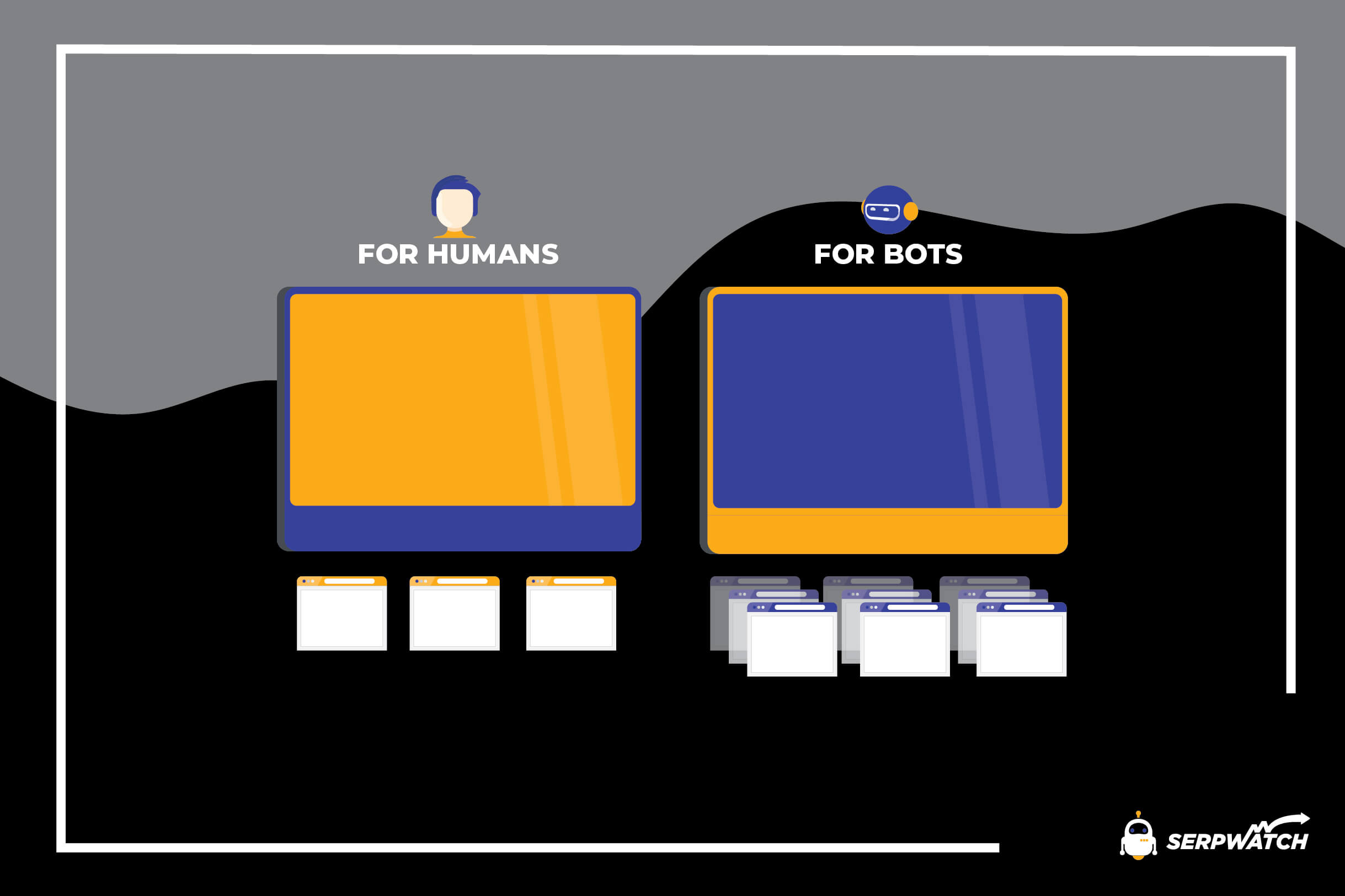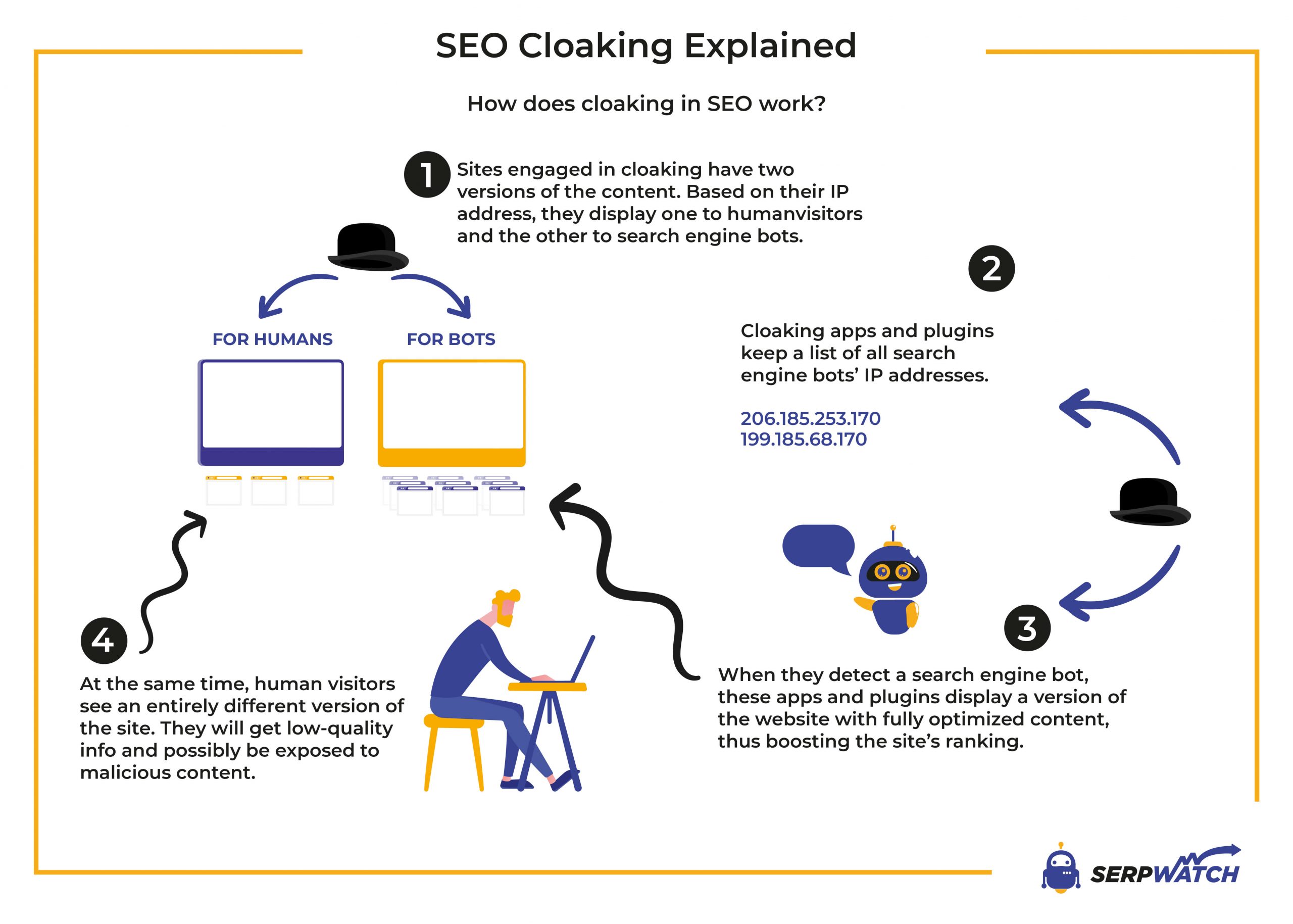
What Is Cloaking in SEO: 2024 Guide

Using the so-called black hat SEO techniques is like joining the dark side. Even though these methods might provide short-term benefits and trigger an uptick in rankings, they are against the rules. Well, cloaking is one of those methods.
Modern search engines can discover almost any shady business, but many web admins still use cloaking despite knowing how SEO works. So, if you want to learn more about cloaking in SEO, let’s explore the topic in detail.
Find in this article:
- How to define cloaking?
- How beneficial is cloaking for search engine optimization?
- What are the types of cloaking, and how to do it?
- How can you cloak affiliate links with no website?
- How to stop cloaking?
- Is cloaking classified as black hat SEO?
- How can you avoid cloaking?
- How to recognize a cloaking website?
What Is the Role of Cloaking in SEO?
Like almost any other technique in the SEO world, clocking aims at improving rankings in SERPs. When we put it like that, cloaking sounds like an excellent idea because every web admin wants to rank as high as possible.
Yet, cloaking is almost always a double-edged sword, with the cons that far outweigh the pros. And even though cloaking in SEO can bring more harm than good, people still use it.
So, what’s the catch? Why do marketers and SEO specialists turn to cloaking as a viable option? To answer this question, we should first go back to the beginning and revisit the basics. In other words, let’s define the concept and start from there.

What Is the Meaning of Cloaking?
The term cloaking appears in many areas of life, but the one from sci-fi series like Star Trek might be perfect to explain what we see in SEO. In essence, cloaking means hiding or camouflaging something, shrouding it so no one can see the actual object.
Well, the situation in search engine optimization follows the same principle. In other words, cloaking in SEO will display different content to Google’s crawlers and human visitors. Thanks to this little trick, website owners can create a false reality and move up the SERPs.
Cloaking adjusts the displayed content to the visitor, enabling it to fly under the radar to boost rankings. Many SEO tools can help fight against cloaking, but some can also help set up cloaking systems. Here’s how.
How Do You Do Cloaking in SEO?
As we said, cloaking displays different versions of content depending on the visitor. Primarily, it changes what search engine bots see and what the browser shows to human users when they click on the same URL.
For SEO specifically, cloaking is about tricking the search engine algorithms into ranking the website higher. Unethical techniques like hidden text and links were a part of SEO cloaking back in the day, but they don’t work today.
These days, admins use specific cloaking apps and plugins, or they modify the .htaccess file manually. After changing this file, admins can set up the mod_rewrite module to detect IP addresses belonging to a search engine bot. Then, when the crawler scans the page, it will see optimized content, full of keywords to rank high in SERPs.
Is Cloaking Good for SEO?
Despite the benefits it might bring, cloaking goes against Google’s Webmaster Guidelines. As such, it shouldn’t be a part of an SEO strategy. Instead, marketers should focus on white hat techniques and use rank trackers like SerpWatch to rank high on search engines.
Web admins risk getting their site de-indexed and removed from SERPs in return for a temporary boost in rankings. Since cloaking is black hat SEO and goes against the rulebook, Google penalizes websites that implement this method. For that reason, dirty tricks will never be good for SEO, and they can only have a negative effect.
A decade or so ago, cloaking could have been a viable option. However, the power of search engine algorithms has increased tenfold in the last few years, detecting cloaking with ease.
Can You Cloak Affiliate Links Without a Website Plugin?
As we said earlier, you can either opt to install a plugin for cloaking or change the .htaccess file in the base directory. These two methods should yield the same results, i.e., they will deceive search engine crawlers and present them with an alternative version of the page.
Typically, you’ll find the .htaccess file in the public_html folder, where you can modify it to redirect visitors to another webpage.
Of course, the internet offers many free link cloakers, which primarily play a role in affiliate marketing. By opting for this method, users can customize URLs and disguise the extensive string of letters and numbers comprising a referral link. Also, link customization can protect the commissions earned by affiliate marketers, so many opt to cloak the URLs.
After all, cloaking is not illegal per se, despite going against Google’s guidelines and inviting stringent sanctions if detected.
How to Find a Reliable Link Cloaker?
Generally speaking, even though cloaking is unethical and misleading, some forms of cloaking will find a way around Google’s guidelines. In other words, search engines will not penalize your page for link customization used in affiliate marketing.
Users should recognize the difference between customized URLs and superimposed versions of content. The latter directly affects SEO, and, according to cloaking definition, it changes the visitor-based content, affecting the user experience.
But as long as you don’t mislead the visitors by double-dealing, your website will stay on the safe side. In such a case, checking the list of the best link cloaking software options should provide viable solutions. In addition, the modern cloaking plugins will allow you to customize and shorten URLs to boost traffic and improve conversion rates.
How Do I Stop Cloaking?
If you’ve already implemented a cloaking mechanism, you can reverse the changes and prevent penalization before Google discovers the trick. Also, malware can alter the base directory and activate cloaking without your permission. This method was once popular with adult websites hijacking URLs and displaying 18+ content.
Modifying the website’s base files might require technical knowledge, so most users should consult SEO tips for guidance on how to stop domain cloaking.
In any case, you will need to prevent the .htaccess file from displaying different versions of the page to crawlers. The goal is to provide the same experience for humans and search bots, and cloaking will present these two target groups with alternative content. Recovery plans can repair the damage, but it could take plenty of time and effort. So, it’s best to stop cloaking as soon as possible.
Is Cloaking a Black Hat SEO?
Depending on the type, many specialists and marketers differentiate between white hat and black hat cloaking. It boils down to whether you use cloaking to mislead search engine bots and serve a page that doesn’t comply with SEO principles.
On the other hand, the importance of local ranking triggered the need for personalized content. In these cases, the so-called IP cloaking uses geolocation technologies and adapts the displayed content. It can translate the page for users from a specific location whose browser uses a different language.
Nevertheless, you’ll be walking a thin line by implementing cloaking tactics on your website. In short, cloaking falls under the category of black hat SEO as long as the clicked URL fails to meet visitor’s expectations and displays alternative content.
How to Avoid SEO Cloaking?
By now, you should have an understanding of the risks associated with cloaking in search engine optimization. Even if you only want to experiment with the website, cloaking should not be on the list. It’s not worth it, and you’ll be playing with fire.
So, how to avoid cloaking? Well, less experienced marketers and web admins should start by asking themselves, “What is cloaking in SEO?” To be precise, it’s essential to know how to recognize cloaking and then use other methods to improve your search engine rankings.
For instance, apps like SerpWatch can help with keyword research, which you can then use to create content that will attract traffic. Many other optimization techniques can also boost your organic search results, reducing the need for cloaking.
How Do You Know If a Website Is Cloaking?
The more you learn about SEO and digital marketing, the better you’ll get at recognizing various black hat SEO techniques. Aside from cloaking, admins sometimes use article spinning, duplicate content, paid backlinks, or even keyword stuffing. So, it’s crucial to recognize and remove these elements as soon as you start working on a website.
For cloaking, the most convenient method would be to use an online cloak checker. Best of all, these free tools will detect search engine cloaking and test the page for hidden scripts of URLs.
By monitoring your website regularly, web admins can detect cloaking attempts and prevent further damage. Therefore, it’s vital to test the URLs and keep an eye on the page’s performance at all times. SEO is a never-ending battle, so it’s crucial to stay alert and act accordingly.
The Takeaway
As tempting as it might be, cloaking is not the way to go. If you want to rank higher in SERPs, many other techniques will yield better results in the long run. Furthermore, cloaking in SEO is too risky because Google has a no-nonsense policy regarding black hat SEO tactics.
Instead, marketers and SEO specialists should focus on content that provides value and responds to search intent. With SerpWatch, you can find the best keywords to rank for and gain insights into improving user experience. After that, your organic traffic should only increase.






There are currently no comments.
Be the first!))